
When someone is looking into getting into embroidery, they are likely to hear about two different kinds, needlepoint and cross stitch.
Needlepoint is a form of embroidery made on a stiff, plastic, or fabric canvas using various materials such as thread. Cross stitching is done on a flexible canvas and uses thread to create its designs.
In the rest of this article, you will read about needlepoint vs. cross stitch, the key differences, and a little bit about what embroidery is in general and what other types of embroidery exist.
Needlepoint is a type of embroidery done on a stiff, open-weave canvas. It uses blunt needles to move various fabrics through the openings in the canvas to create different designs.
Needlepoint is an art form that has been around for hundreds of years. It involves taking an open-weave canvas, meaning that you can see the holes in the fabric, and stitching different materials through those holes to create a pattern.
Nowadays, needlepoint canvases can be either plastic or fabric and are used to make everything from tiny keychains to rugs.
One of the best parts about needlepoint is that it offers the opportunity to get creative and explore more than other forms of embroidery. This is because you are not limited in the materials that you can use.
Since the canvas is so open, you can experiment with many different materials and textures. Some of the most popular materials used are yarn, embroidery floss, as well as various scrap fabrics.
These also provide the finished product with a unique look and feel that you can’t get with other forms of embroidery.
Cross stitch came to popularity in the 1700s and is still well known to this day due to its versatility and relative simplicity.
Cross stitch is a form of embroidery in which you stitch designs into a flexible, cotton fabric using cross stitch. It uses both blunt tapestry needles and sharp embroidery needles to create intricate designs.
Cross stitch is done on a soft, flexible cotton fabric that is stretched across a hoop that holds the fabric taught. You will then use a blunt or sharp needle to stitch cross stitches into the fabric in the pattern of whatever design you’re following.
The thread used for cross stitch is almost always embroidery floss. This is a thin cotton thread that can be found in most craft and fabric shops. Depending on the density of the canvas, you can also pull the floss apart to make it thinner to create a more delicate design.
Out of all the forms of embroidery, cross stitch is widely considered the easiest to learn.
It typically only involves one type of stitch, which means that you won’t have to waste time constantly googling new stitches while trying to follow your pattern.
Cross stitch is also a counted embroidery style meaning that you count all of the stitches, and that is how you create your design. This can also make it easier for beginners to pick up as they can rely on the pattern more heavily than in non-counting styles.
Considering the fact that both needlepoint and cross stitch are forms of embroidery, there are many similarities between the two. Some of these similarities include the following:
When doing both needlepoint and cross-stitch embroidery, you are typically following a pattern. These patterns, like the Dakota Collectibles Quilt Stitch Patterns Embroidery Designs, can be found and purchased online or in stores and detail both the thread, canvas, and needle that you’ll need to complete the project.
Both of these forms of embroidery are considered counting embroidery. This means that you have to know how many stitches to do in a row to create the pattern. The number of stitches will also be labeled on the pattern.
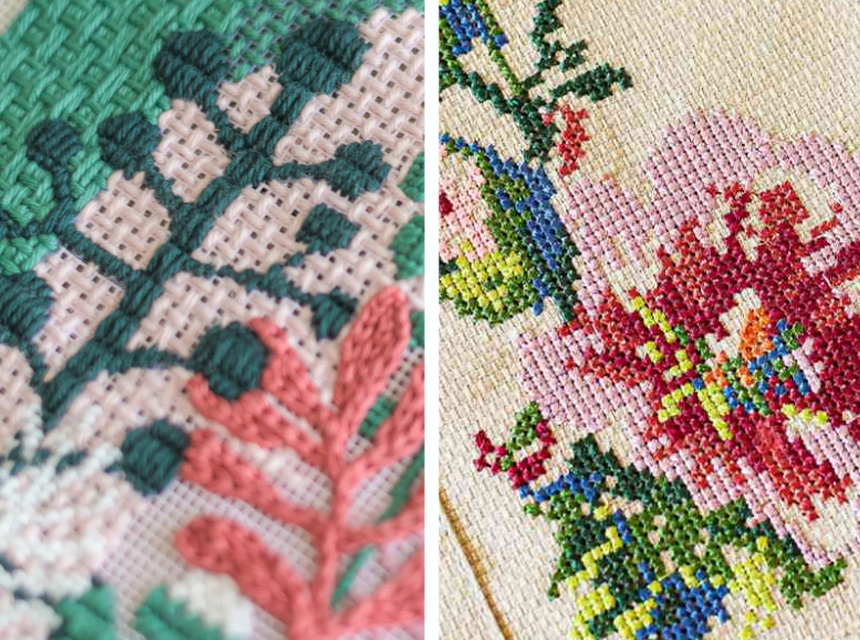
Although needlepoint has significantly more variation than cross stitch in terms of stitching, they do have some overlap. Both needlepoint and cross stitch utilize something called the tent stitch.
This is when the thread is crossed over the intersection of the fabric but isn’t crossed over a second time to form an X. Instead, the stitch forms a diagonal line.
Although both needlepoint and cross stitch are types of embroidery, there are many differences between the two. Some of these differences are:
Cross stitch is typically made using an even-weave cotton fabric known called Aida. It is a soft cotton fabric. Its degree of openness, meaning how easily you can see the holes in the fabric, varies.
Beginners will often choose to use a more open weave, while more experienced cross stitchers prefer the seamless look of a tighter weave.
In contrast, needlepoint is done on a stiff, open-weave canvas that typically has very large, obvious holes for the thread to be stitched through. Depending on the project, these canvases can be made of fabric or plastic.
Another difference when looking at the comparison of needlepoint vs. cross stitch is in the type of thread that is used for the embroidery.
For cross stitching, people usually use what is known as embroidery floss. Embroidery floss is a thin cotton thread that is sold in bundles and can be found in most craft stores. You can also pull the floss into individual threads depending on how thick you want your stitch to be.
Embroidery floss comes in many bright colors, and they’re typically standardized. That way, when you’re looking at a pattern online, you can see the reference number for the color used and find it in the store.
In terms of thread used, needlepoint has no rules. Since the gaps in the canvas for needlepoint are significantly larger, you can use more materials than just standard embroidery thread.
Many people use materials such as cotton, wool, tulle, and various yarns. They may also intermix embroidery floss for a more delicate look.
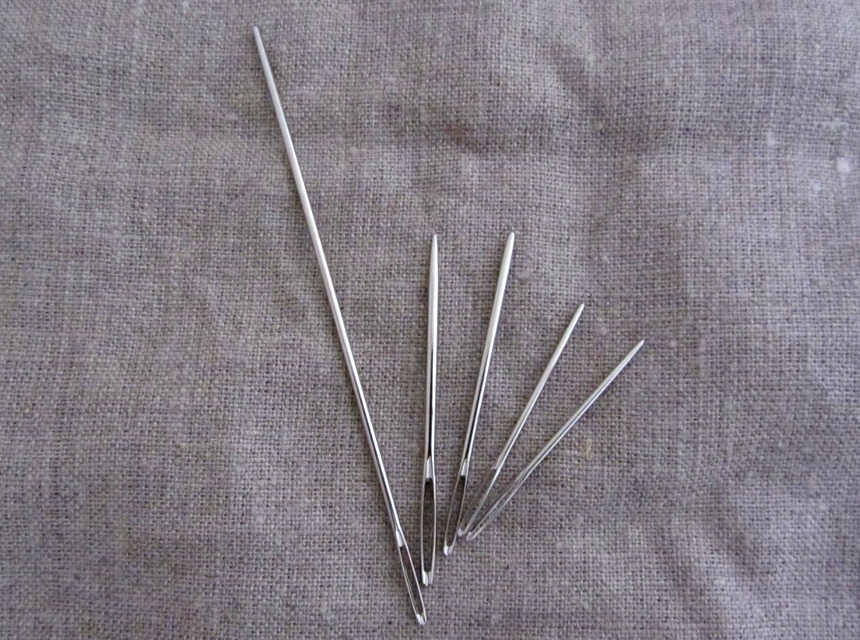
There are two main types of needles used for cross stitches, tapestry needles and embroidery needles, and each will be used for a different canvas.
Tapestry needles are thicker and have blunt tips. This makes them a great option if you are using a canvas that has a more open weave since the tip will not need to go through the actual fabric, just the gaps.
They are also great for beginners because, for one, they don’t hurt as badly if you accidentally stab yourself, and two, it is harder to go through the fabric instead of the hole.
Embroidery needles are ideal for designs that are more delicate or for when you’re using a canvas with a tighter weave.
These needles have sharp tips, which will allow the needles to go through the canvas more easily, especially if there is a tighter weave. The risk of using these is that it’s easier to go straight through the fabric, and they’re sharp, as was already mentioned.
Since there is no need to go through any tiny holes in needlework, most people use tapestry needles or no needles if the canvas is especially open.
The stitches used in cross stitch are very distinct. They cross directly over the intersections in the fabric, and when you look at an individual stitch, it looks like an X. That’s where cross-stitching gets its name. Although there is some variation in the stitches, the majority will follow this crossed pattern.
In contrast, the basic stitch for needlepoint is a tent stitch. A tent stitch is half of a cross stitch; it just does not cross over the second time.
Depending on the material used in the needlepoint, the density of these stitches will vary. If the material being used is very thick yarn and the person does not want the piece to appear crowded, they may choose to leave more space between every stitch.
One major difference between cross stitch and needlepoint is that cross stitch uses a hoop, while needlepoint was not.
Since the fabric used for cross stitching is so flexible, it is necessary to use a hoop to hold the fabric taught, so it doesn’t move around. If you don’t do this, then the stitches can start to pull the fabric in different directions, and it won’t lay flat anymore.
The hoops can be made from wood or plastic and come in many different sizes depending on how big your embroidery piece will be.
Since needlepoint is done on a stiff canvas, the hoop is unnecessary. The canvas won’t bend from the tension of the stitches, so you can simply hold the canvas and embroider away.
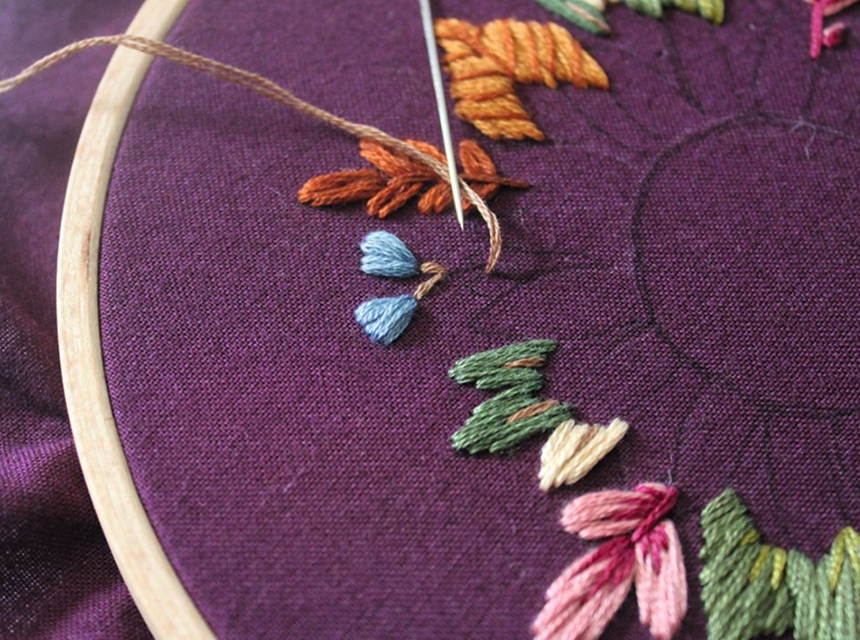
The easiest way to define embroidery Trusted Source What Is Embroidery and What Are the Main Types of Embroidery? Domestika Learn about the infinite possibilities of this technique If we wanted to define it in the simplest way, we could say that embroidery is a technique that consists of using a needle and thread to decorate fabric. www.domestika.org is by saying it’s the art of using needles and thread to decorate fabric.
There are many different variations of embroidery, two of which have already been discussed in this article, needlepoint and cross stitch. Sometimes there is confusion, and people end up comparing needlepoint vs. embroidery or cross stitch vs. embroidery, thinking that they are different. However, it’s all embroidery.
Cross stitch and needlepoint are two of the most common forms of embroidery and are still popular today, with many people enjoying the process of adorning their clothes, cushions, pillowcases, etc.
Although there are an infinite number of embroidery styles, and many have tried to categorize them, it is virtually impossible.
However, for the sake of today’s article, we will be splitting embroidery into two different subtypes: machine embroidery and hand embroidery.
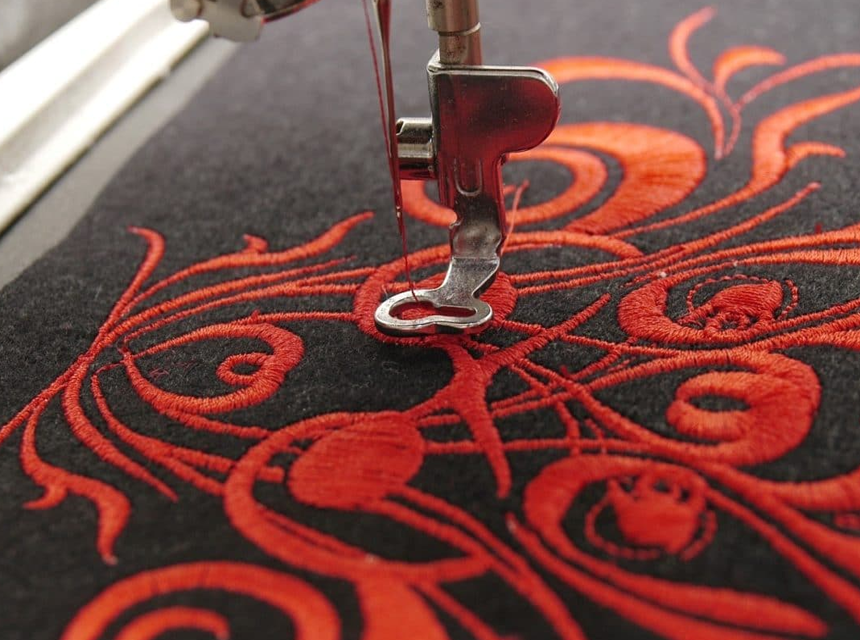
Machine embroidery is different from traditional embroidery because it is no longer done by hand. However, outside of that, it is much the same.
To make machine-embroidered fabric, you’ll first need a specialized sewing machine programmed with embroidery-style stitches. There are two types of sewing machines that can be used for machine embroidery, free-motion and computerized sewing machines.
A free-motion sewing machine is the same thing as a regular sewing machine that is programmed with embroidery stitches. You are the one moving the fabric through the machine, changing the style of stitching, and changing the color of the thread in and out.
The downside to using a free-motion machine is that it is far more time-consuming and creates more user errors. After all, you are the one responsible for either creating the pattern as you go or following the pattern. You are also responsible for maintaining appropriate tension and getting the design straight.
The benefit of using a free-motion machine is that, as the name suggests, you have more freedom to create your own design. You can change design elements as you go depending on what you think the piece needs, and overall, it offers a more humanistic touch to the art.
Computerized sewing machines are specialized sewing machines that are controlled by computers that can take a design and embroider it directly onto the fabric.
Nowadays, there’s even technology, like the Singer Futura XL-400 & XL-550 Auto Cross-Stitch Software, that allows you to take an image and transform it into a unique design.
This allows the machine to have more precision as well as produce pieces more rapidly. This is the type of machine that is used in most clothing factories to mass-produce their products.
The downside to this type of machine is that since it produces identical products, you are missing out on the artistic aspect of embroidery.
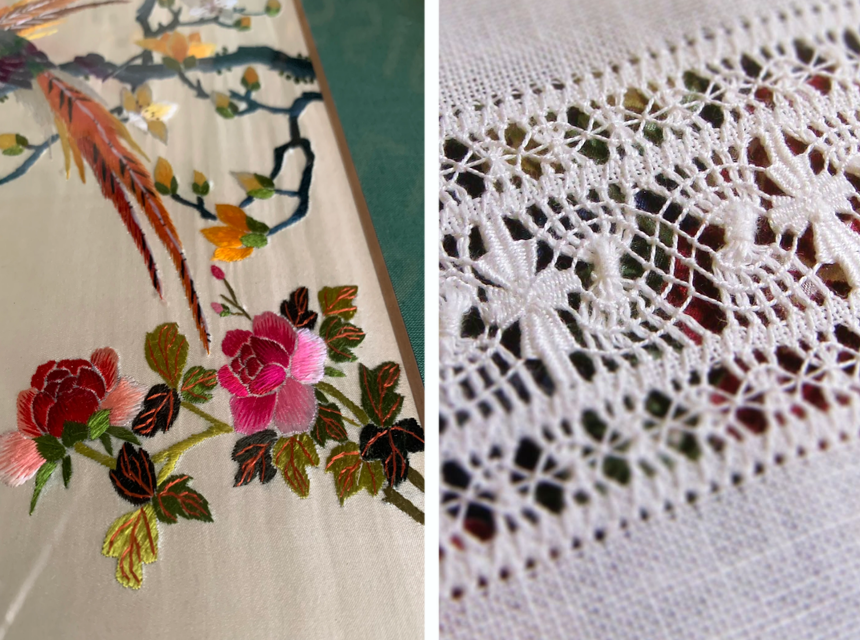
As the name suggests, hand embroidery is any embroidery that is done by hand. This includes needlepoint and cross stitch.
However, there are many other, lesser-known forms of embroidery all over the world that offer their own unique beauty. Some of these types are:
These are all more ancient forms of embroidery that are specific to the region they originated from and are rarely practiced in different parts of the world. However, studying these styles of embroidery offers insight into the history of those countries and how their culture evolved over time.
The type of embroidery that you should use will depend on the goals that you have for your project.
If you are skilled at embroidery and you want to be able to create a unique piece that nobody has ever seen before, then you should stick to one of the free stitch styles. This will allow you to create and alter your design as you go without having to worry about whether or not you’re following the pattern correctly.
If you’re a beginner and you’d like to create something simple, such as a pillowcase, and aren’t ready to create your own design, cross stitch could be a great option. There are thousands of free patterns on the internet that will allow you to create whatever you desire. There are also plenty of tutorials available online that will help you get started.
Needlepoint is great for larger products or if someone would like to experiment with new textures and materials. With needlepoint, you can make everything from a bookmark to a tapestry for your wall.
Finally, we come to the last comparison. Which one is better, needlepoint vs. cross stitch vs. embroidery?
In short, there is no single better option. Each type of embroidery will be ideal for a different person depending on their goals.
Needlepoint is great for larger-scale projects and is lots of fun to experiment with since you can use so many different fabrics in place of thread.
Cross stitch is great for beginners or for someone who simply wants to follow a pre-existing pattern and have a beautiful result. It can also be easier to learn as there is an abundance of online tutorials available for those wanting to learn.
Needlepoint vs. cross stitch: how do they compare? Both are forms of embroidery that have been around for hundreds of years. Even though they are both embroideries, they have several key differences.
Needlepoint is performed on a stiff canvas and uses various materials to decorate the canvas. Some of the most popular materials are yarn and scrap fabric.
Cross stitch is done on a flexible cotton fabric, and the thread used is typically a very fine thread called embroidery floss. Cross stitch is considered one of the easiest forms of embroidery to learn and is enjoyed by people of all ages.